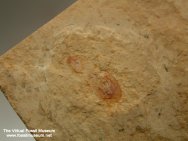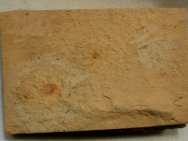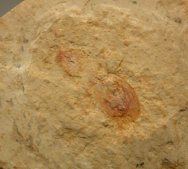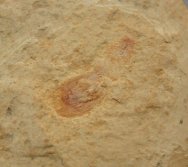Sicyophorus rarus
Phylum Priapulida
Geological Time: Early Cambrian (~525 million years ago)
Size (25.4mm=1 inch): 8 mm long by 3 mm across on a 29 mm by 45 mm matrix
Fossil Site: Chengjiang - Quiongzhusi Section, Yu’anshan Member, Heilinpu Formation, Mafang Village, Anning, Kunming, Yunnan Province, China
Discovered in 1984, the Chengjiang Biota now ranks as the most diverse faunal fossil assemblage of all the Burgess Shale like deposits. It is also some 10 million years older than the Burgess Shale. Like the Burgess Shale, non-mineralized soft tissue parts are often extraordinarily well preserved with high resolution as aluminosilicate films, sometimes with oxidized iron content. Various taphonomic processes leading extensive preservation of soft tissue have been proposed, including rapid death by asphyxia followed by rapid burial in anoxic sediment undisturbed by turbidity. The Chengjiang biota is dominated by phyla Arthropoda and Porifera. There are seven lobopodians, more than any other Lagerstätte that some scientists elevate to the phylum rank Lobopodia, and seven members of the extinct phylum Vetulicolia. Members or potential members of phyla Priapulida, Nematomorpha, Hyolitha, Hemichordata, Echinodermata, Ctenophora, Chordata, Cnidaria, Chaetognatha, and Brachiopoda are found. A large number of enigmatic animals of uncertain affinity are found as well, some of which may represent failed evolutionary experiments, or even new phyla that did not persist for long in the early to middle Cambrian, or were rapidly replaced by more derived forms. Among the diverse Maotianshan Shales fauna, of utmost important are the putative early chordates, particularly Haikouella, potentially an ancestor to or the earliest craniate chordate. Myllokunmingia and Haikouichthys are interpreted as early Craniata, and possibly very primitive agnathids, the progenitor of the fishes and all vertebrates. Also see: Chengjiang Maotianshan Shales, Chengjiang Biota, Chengjiang Fossils, Cambrian Explosion |

 Palaeopriapulites parvus, parvus meaning small in
the Latin, are normally less than 10 mm long and exhibit a figure
eight shape. This one possesses a coiled gut not seen in
Palaeopriapulites parvus, parvus meaning small in
the Latin, are normally less than 10 mm long and exhibit a figure
eight shape. This one possesses a coiled gut not seen in 

